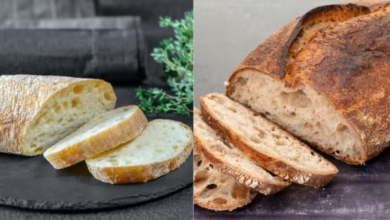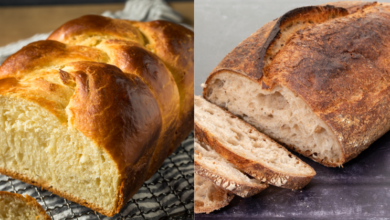The Science Behind Sourdough Bread – What Is Sourdough Bread?
What To Know
- Sourdough bread is a unique and flavorful type of bread made using a fermented dough.
- During this time, wild yeast and bacteria in the air and on the flour begin to grow and multiply, creating a natural leavening agent.
- Cover the bowl with plastic wrap and let the dough rise in a warm place for 8-12 hours, or until it has doubled in size.
Sourdough bread is a unique and flavorful type of bread made using a fermented dough. This fermentation process, which relies on wild yeast and bacteria, gives sourdough bread its characteristic tangy flavor, chewy texture, and extended shelf life.
The History of Sourdough Bread
Sourdough bread has a long and rich history, dating back to ancient Egypt. It is believed that the first sourdough breads were created by accident when flour and water were left to ferment naturally. Over time, bakers began to cultivate and maintain sourdough starters, which allowed them to control the fermentation process and produce consistent results.
How is Sourdough Bread Made?
The process of making sourdough bread begins with creating a sourdough starter. This is a mixture of flour and water that is allowed to ferment for several days. During this time, wild yeast and bacteria in the air and on the flour begin to grow and multiply, creating a natural leavening agent.
Once the starter is mature, it is added to a dough mixture made with flour, water, and salt. The dough is then kneaded and allowed to rise for several hours. During this time, the wild yeast and bacteria in the starter ferment the sugars in the flour, producing carbon dioxide gas. This gas creates bubbles in the dough, causing it to rise.
The Benefits of Sourdough Bread
Sourdough bread offers several potential benefits over other types of bread:
- Improved digestion: The fermentation process in sourdough bread breaks down some of the complex carbohydrates in the flour, making it easier to digest. This can be beneficial for people with certain digestive issues.
- Increased nutrient absorption: The fermentation process also increases the availability of certain nutrients in the bread, such as iron, zinc, and B vitamins.
- Longer shelf life: Sourdough bread has a naturally longer shelf life than other types of bread due to the presence of lactic acid, which inhibits the growth of mold.
- Unique flavor: Sourdough bread has a distinctive tangy flavor that many people find appealing.
The Different Types of Sourdough Bread
There are many different types of sourdough bread, each with its own unique flavor and texture. Some of the most common types include:
- White sourdough: Made with white flour, white sourdough bread has a mild flavor and a soft, fluffy texture.
- Whole wheat sourdough: Made with whole wheat flour, whole wheat sourdough bread has a nutty flavor and a denser, chewier texture.
- Rye sourdough: Made with rye flour, rye sourdough bread has a slightly sour flavor and a dense, chewy texture.
- Sourdough baguettes: Long and thin, sourdough baguettes have a crispy crust and a chewy interior.
How to Make Sourdough Bread at Home
Making sourdough bread at home can be a rewarding experience. Here is a basic recipe to get you started:
Ingredients:
- 1 cup sourdough starter
- 3 cups all-purpose flour
- 1 cup water
- 1 teaspoon salt
Instructions:
1. In a large bowl, combine the sourdough starter, flour, water, and salt.
2. Mix until the ingredients are well combined and form a sticky dough.
3. Cover the bowl with plastic wrap and let the dough rise in a warm place for 8-12 hours, or until it has doubled in size.
4. Once the dough has risen, punch it down and shape it into a loaf.
5. Place the loaf on a baking sheet lined with parchment paper.
6. Cover the loaf with plastic wrap and let it rise for another 2-4 hours, or until it has doubled in size.
7. Preheat the oven to 450°F (230°C).
8. Bake the loaf for 30-40 minutes, or until it is golden brown and crusty.
9. Let the loaf cool on a wire rack before slicing and serving.
Tips for Making Sourdough Bread
- Use a good quality sourdough starter. The quality of your sourdough starter will have a big impact on the flavor and texture of your bread.
- Be patient. Sourdough bread takes time to make. Don’t rush the process, and allow the dough to rise fully before baking.
- Experiment with different flours. Different flours will produce different flavors and textures. Try experimenting with whole wheat flour, rye flour, or even spelt flour.
- Don’t be afraid to fail. Making sourdough bread can be a bit of a trial and error process. Don’t get discouraged if your first few loaves don’t turn out perfect. Just keep practicing, and you’ll eventually get the hang of it.
Sourdough Bread: A Versatile and Delicious Staple
Sourdough bread is a versatile and delicious staple that can be enjoyed in many different ways. It can be sliced and toasted for breakfast, used to make sandwiches and wraps for lunch, or served as a dinner accompaniment. Sourdough bread is also a great choice for making croutons, bread crumbs, and other culinary creations.
Beyond Bread: Other Uses for Sourdough
While sourdough bread is undoubtedly the most popular use for sourdough starter, there are many other ways to enjoy this fermented goodness. Here are a few ideas:
- Sourdough pancakes: Make fluffy and tangy pancakes by substituting sourdough starter for some of the milk in your favorite pancake recipe.
- Sourdough waffles: Elevate your waffle game with sourdough starter. Add it to your batter for a crispy exterior and a chewy interior.
- Sourdough pizza crust: Create a unique and flavorful pizza crust by using sourdough starter instead of commercial yeast.
- Sourdough crackers: Bake crispy and addictive sourdough crackers that are perfect for snacking or pairing with dips.
- Sourdough doughnuts: Indulge in guilt-free doughnuts made with sourdough starter. They’re fluffy, tangy, and surprisingly healthy.
Frequently Asked Questions
What is the difference between sourdough bread and regular bread?
Sourdough bread is made with a sourdough starter, which is a fermented mixture of flour and water. This fermentation process gives sourdough bread its characteristic tangy flavor, chewy texture, and extended shelf life. Regular bread, on the other hand, is made with commercial yeast, which produces a milder flavor and a softer texture.
Is sourdough bread healthy?
Sourdough bread is generally considered to be healthier than regular bread. The fermentation process breaks down some of the complex carbohydrates in the flour, making it easier to digest. Sourdough bread also contains more nutrients than regular bread, such as iron, zinc, and B vitamins.
How long does sourdough bread last?
Sourdough bread has a longer shelf life than regular bread due to the presence of lactic acid, which inhibits the growth of mold. Sourdough bread can typically last for 3-5 days at room temperature or up to 2 weeks in the refrigerator.
Can I make sourdough bread without a sourdough starter?
Yes, it is possible to make sourdough bread without a sourdough starter. However, the process is more difficult and time-consuming. You will need to create a sourdough starter from scratch by combining flour and water and allowing it to ferment for several days. Once you have a sourdough starter, you can use it to make sourdough bread as described above.
What is the best way to store sourdough bread?
Sourdough bread can be stored at room temperature or in the refrigerator. If you store it at room temperature, keep it in a bread box or other airtight container. If you store it in the refrigerator, wrap it in plastic wrap or place it in a resealable bag.


